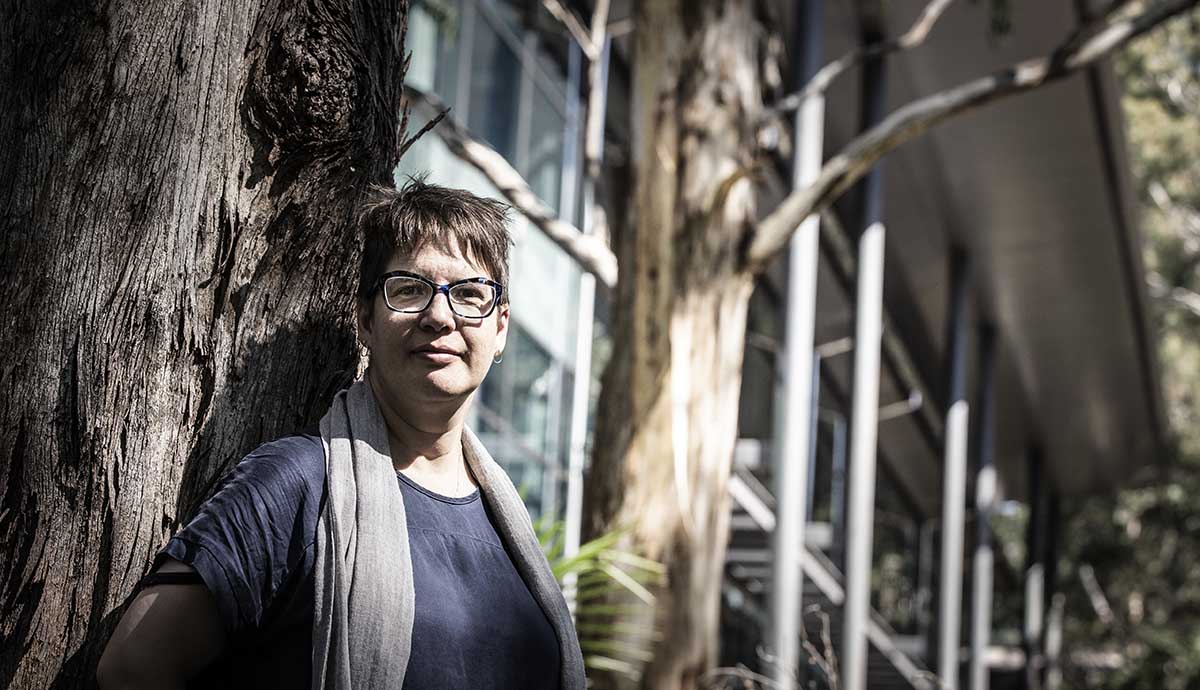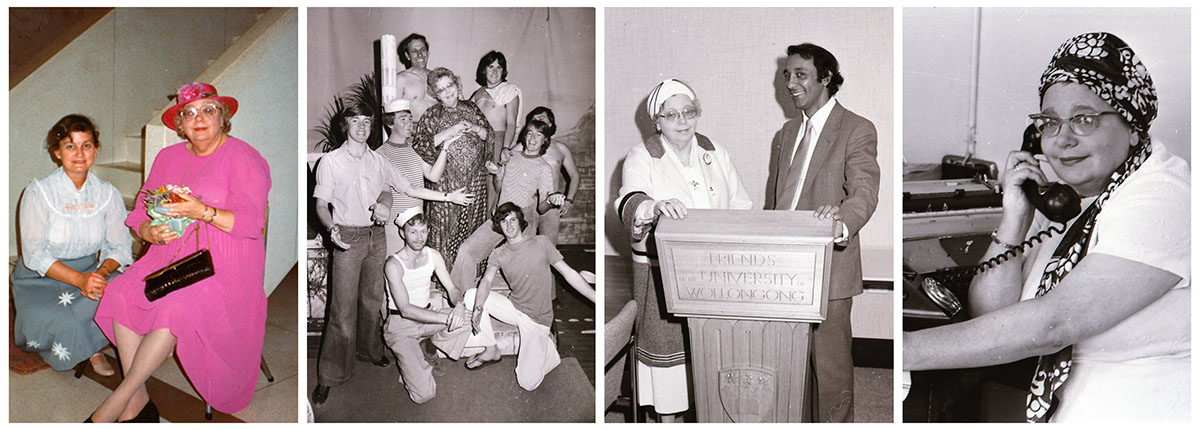April 9, 2019
Ethel Hayton: avid arts advocate or social-climbing busybody?
Exhibition explores the fascinating life of ‘Wollongong’s most outstanding citizen’
Flamboyant and a bit eccentric, always dressed in hats and jewellery, Ethel Hoskins Hayton wasn’t rich, wasn’t famous and wasn’t always popular, but without her, Wollongong would be a very different place.
An exhibition, A Woman of Many Hats: Ethel Hayton, MBE, 1913-1988, at the University of Wollongong Library will explore the fascinating life of the woman once described as “Wollongong’s most outstanding citizen”. It runs from 22 April to 26 May in the Panizzi Gallery, with the official opening on Saturday 4 May.
Associate Professor Ika Willis, whose research into Ethel’s life inspired the exhibition, is calling on Illawarra residents who knew Ethel (pictured above with Dr Edgar Beale and UOW Chancellor Justice Robert Hope, at a graduation ceremony in 1979) to share their memories and contribute to the exhibition.
Dr Willis, a lecturer in English Literatures in UOW’s School of The Arts, English and Media, says her interest in Ethel was sparked by a photograph on the Wollongong laneway that bears Ethel’s name.
“I got interested in her because of the Ethel Hayton walkway which links two of my favourite places in Wollongong – the cafe Lee & Me and the arts precinct. There she was in her fabulous black-and-white hat. She'd obviously been hugely important to the city, especially the arts scene, without ever holding an official position and I wanted to know more,” Dr Willis said.
“She helped build the Wollongong we live in today. There’s very little visible sign of what she did, but she’s embedded in every brick.”
Born in England in 1913, Ethel immigrated to Wollongong with her mother in 1930, joining her father who had moved here earlier. Her father died 16 months later leaving his widow and daughter with, as Ethel put it, “quite frankly, and I mean this most sincerely, no money”.
He did, however, leave them a bookshop-library on lower Crown Street. Ethel lived in Crown Street the rest of her life, first above the shop (where Bob Onofri Real Estate now is), later in a flat above what is now Lee & Me.
Ethel worked as a journalist for The Advance, a free paper, from 1948 until it closed in 1960; she also worked for the Illawarra Mercury, News Limited, and the ABC. Most of her time and energy, however, went into Wollongong itself, especially its churches, its arts and cultural scene, and activities relating to new migrants.
“Ethel was involved in everything,” Dr Willis said. “Every time I come across a new source of information I find out about one more organisation she helped to found, or worked for – today I discovered she was a founding member of the Committee for the Wollongong Conservatorium of Music.
“She never married and had no children, and the engine of her life really does seem to have been the city she lived in: she defended it fiercely and worked tirelessly to improve it. From the 1950s to the 1970s she was at every committee meeting, every fundraiser, every social event – at ‘every wake and every wedding’, as one person put it.”
 Dr Ika Willis says her interest in Ethel Hayton was sparked by a photograph on the Wollongong laneway that bears Ethel’s name.
Dr Ika Willis says her interest in Ethel Hayton was sparked by a photograph on the Wollongong laneway that bears Ethel’s name.
Not everyone was a fan, however. To her admirers she was “a survivor and a saint”, “a real English lady”, and an “avid arts lover and advocate”. To her detractors she was “a busybody” and “a fraud”.
“I've heard her described as a busybody, a social climber, and as someone who wanted to impose ‘English’ culture on a rough steel town. I've also heard her described as someone who ‘hated bigotry of any kind’ and was ‘always on the side of the angels’,” Dr Willis said.
Ethel involved herself in everything from judging pet costume competitions (won by a Pekinese dog in a sailor suit) to organising play readings, to serving as the president of the Wollongong branch of the Arts Council.
She was secretary of St Michael's Church choir and a member of its Literary, Historical and Debating society. She was a member of the Orchestral Subscribers Committee, the Eisteddfod, the Migrants’ Committee, the New Australian Social Committee, and the New Settlers’ League.
She was a founding member of the Soroptimists, the ABC International Celebrity Concert Committee, Musica Viva, the Welsh Society and the Art Gallery Society, and a founding donor of the Wollongong Art Gallery. A portrait of Ethel, by Wollongong artist Coralie Barr, was a finalist in the 1973 Archibald Prize.
She ran the campaign to get a Steinway piano for the Wollongong Town Hall (regarded by pianists as one of the two best pianos in Australia at the time), and helped bring the ballets Corroboree (in 1954) and Giselle (in 1969) to Wollongong. The Arcadians Theatre Group called her “Wollongong’s first lady of theatre” and dedicated a gala night of the musical South Pacific to her in 1978.
She was often in the social pages of the Mercury in the 1950s, when one of the chief modes of entertainment was supper parties: when an orchestra or a theatre company or ballet visited, they would be given supper, with an eminent local (usually a woman) hosting.
“In one account, we're told that Ethel and her mother entertained a visiting orchestra – but because their flat was so small, they had to give the party ‘in batches’. I love that, and it seems to sum up the way Ethel managed her champagne tastes on a beer budget!” Dr Willis said.
During her research, Dr Willis discovered the whereabouts of the 1973 Archibald finalist portrait of Ethel. The painting was in New Zealand with artist Coralie Barr’s family. Dr Willis thought it would be a great feature for the exhibition however she was unsure how she would fund both the exhibition and the collection of the portrait.
Thankfully, a generous philanthropic donation to UOW enabled Dr Willis to collect the portrait from New Zealand and provided funds for the exhibition itself.
Ethel Hayton herself was one of the University’s founding donors. She was a member of the 1959 Lord Mayoral Appeal Fund Working Committee which raised £50,000 to aid the establishment of Wollongong University College which later became UOW.
As a founding member of the Friends of the University she campaigned to establish a university in Wollongong and continued to support the University for the rest of her life. She also donated the University a lectern and its ceremonial mace (both by her friend the sculptor Gino Sanguinetti), and left a bequest to endow a Fellowship in Contemplative, Spiritual and Religious Studies.
She was made a Fellow of the University in 1985, and the Ethel Hayton Award and Trophy was presented annually from 1987 to 1998 to a University of Wollongong staff member or group of staff who enhanced the relationship between the University and the community.
People with memories of Ethel that they’d like to share are invited to contact Dr Willis on ikaw@uow.edu.au or 4239 2513 (email preferred or leave a voicemail).
 From the 1950s to the 1970s, Ethel Hayton was at every committee meeting, every fundraiser, every social event, "every wake and every wedding" in Wollongong.
From the 1950s to the 1970s, Ethel Hayton was at every committee meeting, every fundraiser, every social event, "every wake and every wedding" in Wollongong.
:format(jpg)/prod01/channel_3/assets/live-migration/www/images/content/groups/public/web/media/documents/mm/uow257403.jpg)